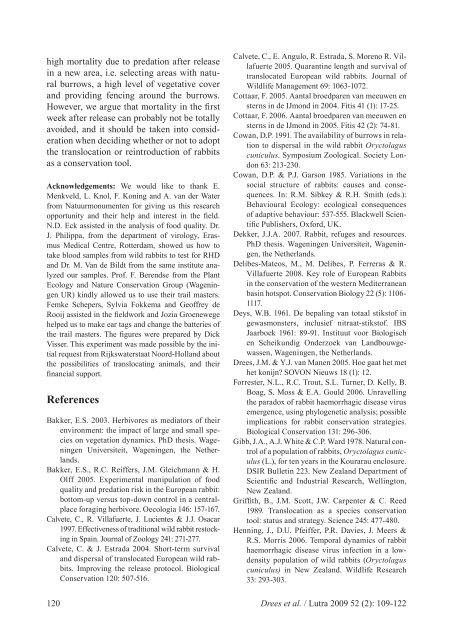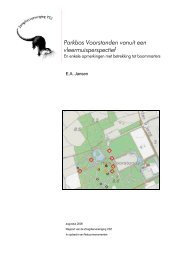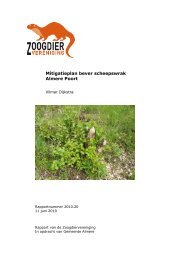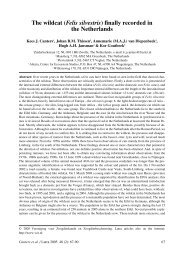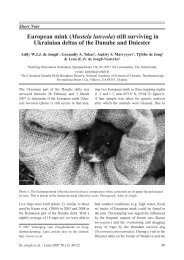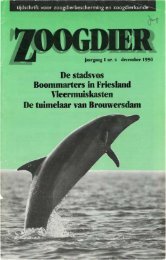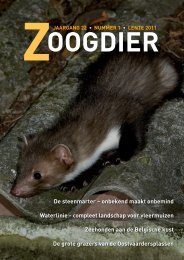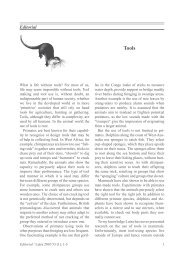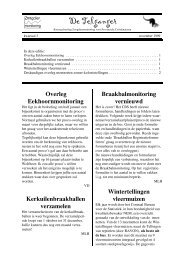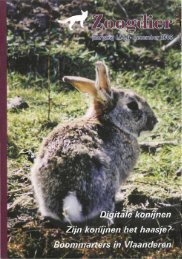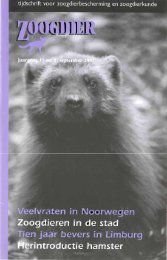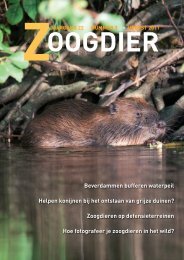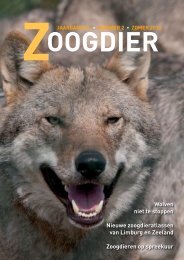The translocation of rabbits in a sand dune habitat - De ...
The translocation of rabbits in a sand dune habitat - De ...
The translocation of rabbits in a sand dune habitat - De ...
You also want an ePaper? Increase the reach of your titles
YUMPU automatically turns print PDFs into web optimized ePapers that Google loves.
high mortality due to predation after release<strong>in</strong> a new area, i.e. select<strong>in</strong>g areas with naturalburrows, a high level <strong>of</strong> vegetative coverand provid<strong>in</strong>g fenc<strong>in</strong>g around the burrows.However, we argue that mortality <strong>in</strong> the firstweek after release can probably not be totallyavoided, and it should be taken <strong>in</strong>to considerationwhen decid<strong>in</strong>g whether or not to adoptthe <strong>translocation</strong> or re<strong>in</strong>troduction <strong>of</strong> <strong>rabbits</strong>as a conservation tool.Acknowledgements: We would like to thank E.Menkveld, L. Knol, F. Kon<strong>in</strong>g and A. van der Waterfrom Natuurmonumenten for giv<strong>in</strong>g us this researchopportunity and their help and <strong>in</strong>terest <strong>in</strong> the field.N.D. Eck assisted <strong>in</strong> the analysis <strong>of</strong> food quality. Dr.J. Philippa, from the department <strong>of</strong> virology, ErasmusMedical Centre, Rotterdam, showed us how totake blood samples from wild <strong>rabbits</strong> to test for RHDand Dr. M. Van de Bildt from the same <strong>in</strong>stitute analyzedour samples. Pr<strong>of</strong>. F. Berendse from the PlantEcology and Nature Conservation Group (Wagen<strong>in</strong>genUR) k<strong>in</strong>dly allowed us to use their trail masters.Femke Schepers, Sylvia Fokkema and Ge<strong>of</strong>frey deRooij assisted <strong>in</strong> the fieldwork and Jozia Groenewegehelped us to make ear tags and change the batteries <strong>of</strong>the trail masters. <strong>The</strong> figures were prepared by DickVisser. This experiment was made possible by the <strong>in</strong>itialrequest from Rijkswaterstaat Noord-Holland aboutthe possibilities <strong>of</strong> translocat<strong>in</strong>g animals, and theirf<strong>in</strong>ancial support.ReferencesBakker, E.S. 2003. Herbivores as mediators <strong>of</strong> theirenvironment: the impact <strong>of</strong> large and small specieson vegetation dynamics. PhD thesis. Wagen<strong>in</strong>genUniversiteit, Wagen<strong>in</strong>gen, the Netherlands.Bakker, E.S., R.C. Reiffers, J.M. Gleichmann & H.Olff 2005. Experimental manipulation <strong>of</strong> foodquality and predation risk <strong>in</strong> the European rabbit:bottom-up versus top-down control <strong>in</strong> a centralplaceforag<strong>in</strong>g herbivore. Oecologia 146: 157-167.Calvete, C., R. Villafuerte, J. Lucientes & J.J. Osacar1997. Effectiveness <strong>of</strong> traditional wild rabbit restock<strong>in</strong>g<strong>in</strong> Spa<strong>in</strong>. Journal <strong>of</strong> Zoology 241: 271-277.Calvete, C. & J. Estrada 2004. Short-term survivaland dispersal <strong>of</strong> translocated European wild <strong>rabbits</strong>.Improv<strong>in</strong>g the release protocol. BiologicalConservation 120: 507-516.Calvete, C., E. Angulo, R. Estrada, S. Moreno R. Villafuerte2005. Quarant<strong>in</strong>e length and survival <strong>of</strong>translocated European wild <strong>rabbits</strong>. Journal <strong>of</strong>Wildlife Management 69: 1063-1072.Cottaar, F. 2005. Aantal broedparen van meeuwen ensterns <strong>in</strong> de IJmond <strong>in</strong> 2004. Fitis 41 (1): 17-25.Cottaar, F. 2006. Aantal broedparen van meeuwen ensterns <strong>in</strong> de IJmond <strong>in</strong> 2005. Fitis 42 (2): 74-81.Cowan, D.P. 1991. <strong>The</strong> availability <strong>of</strong> burrows <strong>in</strong> relationto dispersal <strong>in</strong> the wild rabbit Oryctolaguscuniculus. Symposium Zoological. Society London63: 213-230.Cowan, D.P. & P.J. Garson 1985. Variations <strong>in</strong> thesocial structure <strong>of</strong> <strong>rabbits</strong>: causes and consequences.In: R.M. Sibkey & R.H. Smith (eds.):Behavioural Ecology: ecological consequences<strong>of</strong> adaptive behaviour: 537-555. Blackwell ScientificPublishers, Oxford, UK.<strong>De</strong>kker, J.J.A. 2007. Rabbit, refuges and resources.PhD thesis. Wagen<strong>in</strong>gen Universiteit, Wagen<strong>in</strong>gen,the Netherlands.<strong>De</strong>libes-Mateos, M., M. <strong>De</strong>libes, P. Ferreras & R.Villafuerte 2008. Key role <strong>of</strong> European Rabbits<strong>in</strong> the conservation <strong>of</strong> the western Mediterraneanbas<strong>in</strong> hotspot. Conservation Biology 22 (5): 1106-1117.<strong>De</strong>ys, W.B. 1961. <strong>De</strong> bepal<strong>in</strong>g van totaal stikst<strong>of</strong> <strong>in</strong>gewasmonsters, <strong>in</strong>clusief nitraat-stikst<strong>of</strong>. IBSJaarboek 1961: 89-91. Instituut voor Biologischen Scheikundig Onderzoek van Landbouwgewassen,Wagen<strong>in</strong>gen, the Netherlands.Drees, J.M. & Y.J. van Manen 2005. Hoe gaat het methet konijn? SOVON Nieuws 18 (1): 12.Forrester, N.L., R.C. Trout, S.L. Turner, D. Kelly, B.Boag, S. Moss & E.A. Gould 2006. Unravell<strong>in</strong>gthe paradox <strong>of</strong> rabbit haemorrhagic disease virusemergence, us<strong>in</strong>g phylogenetic analysis; possibleimplications for rabbit conservation strategies.Biological Conservation 131: 296-306.Gibb, J.A., A.J. White & C.P. Ward 1978. Natural control<strong>of</strong> a population <strong>of</strong> <strong>rabbits</strong>, Oryctolagus cuniculus(L.), for ten years <strong>in</strong> the Kourarau enclosure.DSIR Bullet<strong>in</strong> 223. New Zealand <strong>De</strong>partment <strong>of</strong>Scientific and Industrial Research, Well<strong>in</strong>gton,New Zealand.Griffith, B., J.M. Scott, J.W. Carpenter & C. Reed1989. Translocation as a species conservationtool: status and strategy. Science 245: 477-480.Henn<strong>in</strong>g, J., D.U. Pfeiffer, P.R. Davies, J. Meers &R.S. Morris 2006. Temporal dynamics <strong>of</strong> rabbithaemorrhagic disease virus <strong>in</strong>fection <strong>in</strong> a lowdensitypopulation <strong>of</strong> wild <strong>rabbits</strong> (Oryctolaguscuniculus) <strong>in</strong> New Zealand. Wildlife Research33: 293-303.120 Drees et al. / Lutra 2009 52 (2): 109-122


